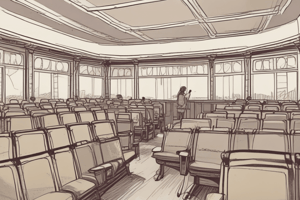Podcast
Questions and Answers
What is the primary focus of 'sitting arrangement' questions in reasoning?
What is the primary focus of 'sitting arrangement' questions in reasoning?
- Determining the best seating configuration for a group of people.
- Analyzing the social dynamics of a group during a seating arrangement.
- Identifying the positions of individuals based on given clues. (correct)
- Evaluating the efficiency of various seating arrangements.
What kind of information is typically used as clues in sitting arrangement puzzles?
What kind of information is typically used as clues in sitting arrangement puzzles?
- The purpose or context of the seating arrangement, such as a meeting, a dinner party, or a classroom. (correct)
- Physical descriptions and personality traits of individuals.
- Relationships between individuals, such as friends, family, or colleagues. (correct)
- Personal preferences of individuals regarding seating positions.
Why are sitting arrangement puzzles considered a part of reasoning?
Why are sitting arrangement puzzles considered a part of reasoning?
- They involve creating a visual representation of the seating arrangement.
- They require the use of logic and deduction to arrive at the correct solution. (correct)
- They are often used in assessment tests to evaluate a person's problem-solving abilities.
- They provide an opportunity to practice critical thinking skills in a fun and engaging way.
Which of these strategies is NOT typically used to solve sitting arrangement puzzles?
Which of these strategies is NOT typically used to solve sitting arrangement puzzles?
What are the key elements of a typical sitting arrangement puzzle?
What are the key elements of a typical sitting arrangement puzzle?
Flashcards
Sitting Arrangement
Sitting Arrangement
The arrangement of individuals in a specific order or position.
Types of Arrangements
Types of Arrangements
Different ways people can be seated, such as circular, linear, or rectangular.
Adjacent Seating
Adjacent Seating
Individuals sitting next to each other in the arrangement.
Opposite Seating
Opposite Seating
Signup and view all the flashcards
Arrangement Logic
Arrangement Logic
Signup and view all the flashcards
Study Notes
Introduction to Seating Arrangements in Reasoning
- Seating arrangements are a common topic in reasoning and problem-solving.
- These problems typically involve a set of people or objects arranged in a specific order or pattern, often on a circular or linear arrangement.
- The questions often require deductive reasoning to determine the final arrangement based on given clues or conditions.
- Problems may involve various relationships and constraints between the positions, such as specific people sitting next to each other, or particular persons placed opposite or at a particular distance from another.
- The difficulty of the problems varies depending on the complexity of the constraints and the number of individuals involved.
Types of Seating Arrangements
- Linear Arrangement: People are seated in a row, such as in a theater or classroom.
- Circular Arrangement: People are seated around a table or circle. Positioning relative to other people is important.
- Combination of Linear and Circular: Problems can combine linear and circular arrangements, with a linear arrangement of people seated around different tables, etc.
Key Strategies for Solving Seating Arrangement Problems
- Careful Reading: Understanding the problem statement is paramount, identifying constraints and relationships clearly.
- Visual Representation: Drawing a diagram, whether a linear or a circular one, helps in visualizing the arrangement.
- Deductive Reasoning: Using the given information and combining the constraints to deduce the correct order.
- Systematic Approach: Solving by systematically testing potential arrangements, using a logical way to examine possibilities based on clues.
- Elimination: Once you've identified some elements, use the remaining statements to eliminate wrong positions and reduce possibilities.
- Logical Constraints: The arrangement should always satisfy the given constraints.
Key Elements in Seating Arrangement Problems
- Relationships: Specific relationships between persons, such as neighbors, opposite to each other, third from, etc.
- Conditions: Restrictions or rules that govern the arrangement, like "A and B must not be next to each other," or "someone is placed specifically on either end".
- Order of Data: The arrangement is often found through carefully analyzing given clues or data. Some constraints can be more dominant than others.
- Multiple Possible Positions and Combinations: Often, there may be more than one answer initially, meaning careful elimination and checking for logical consistency is important.
Common Types of Clues in Seating Arrangement Problems
- Adjacent Sitting: "X is sitting next to Y".
- Opposite Sitting: "X is sitting opposite to Y".
- Specific Positions: "X is sitting at the start/end," "X is fourth from the left", "Z is second left from K".
- Groupings: "Group XYZ are sitting together".
- Alternating Positions: "People are sitting alternately across the table".
- Specific Relationships: Familial connections or other relationships also influence the arrangement, sometimes being part of the constraints.
Importance of Practice and Analysis
- Regular Practice: Solving various seating arrangement problems helps in creating patterns and improving reasoning skills.
- Analyzing Solutions: After solving a problem, reviewing how the solutions were deduced and identifying systematic strategies. Reflecting on how you used clues and logic helps reinforce the reasoning skills involved in seating arrangement problems.
Studying That Suits You
Use AI to generate personalized quizzes and flashcards to suit your learning preferences.




